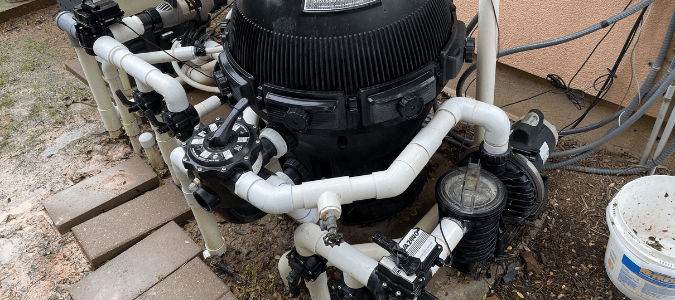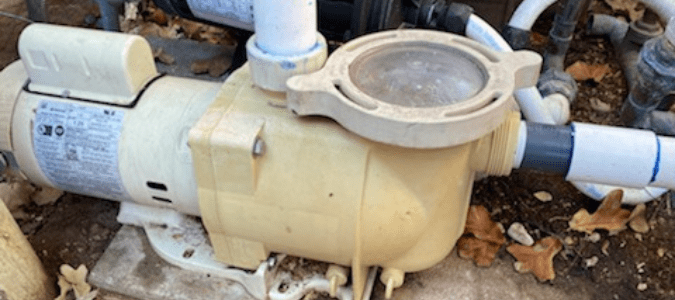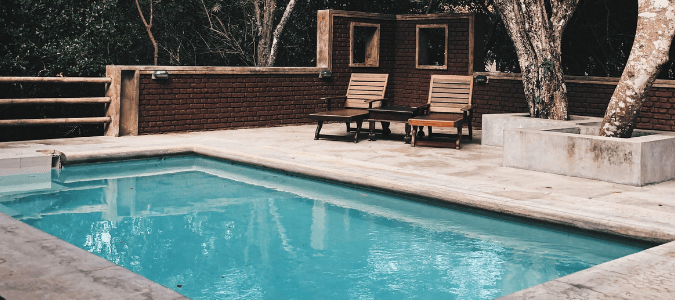“Why is my pool pump leaking from the top?” This is a question many homeowners with pools ask certified pool professionals when they find their pool pump is leaking. Discovering a leak in your pool pump can be frustrating, but these leaks are actually very common.
Pool pumps have many different components, including a motor and housing as well as various gaskets, clamps and o-rings. If any of these parts breaks or wears out, it can cause a leak. Having too little water in your pool can also lead to a leak, since it can allow air into the pump. Of course, low water levels in the pool can also be the result of a pump leak, not the cause of it. In these cases, it can be helpful to learn your pool’s evaporation rate.
Whatever is causing the leak needs to be fixed as soon as possible. Some pump leaks can create fire hazards. Even a slow pump leak can turn into a major problem that leads to expensive water bills. This is why it’s important to determine the cause of the issue so you can have it fixed.
When your pool pump is leaking from the top, it can look like a leak from the bottom. Water leaking from a spot higher up on the pump will drip or flow downward. To see exactly where the leak is coming from, you may need to bend down and use a flashlight.
Quick Fixes
Sometimes, pool pump leaks are a relatively simple issue like a loose clamp or a missing or worn-out o-ring. Some homeowners find it easy enough to tighten a clamp or replace an o-ring themselves. If you choose to tackle this type of issue, be sure to turn off the power to the pool pump before you start. Otherwise, you could be risking electric shock.
It’s also a good idea to make a visit to your local pool store before you start any pool pump fix-it project. Talking with a professional there will help you understand your project better. If you’re buying a replacement part, it will also help to ensure that you get the right one for your particular pump.
There are several parts of the pump that are the most common spots for leaks to develop. These include the pump lid and housing, the shaft seal, and the inlet and outlet fittings. In most cases, these parts start leaking because they crack or shrink due to temperature fluctuations over time.
Leak Coming From the Pool Pump Lid
The pump lid can leak if it cracks or breaks. Keep in mind that this part will leak only when the pump is not running. Lots of people miss a leaking lid when searching for the source of a pool pump leak. This is because they look for water coming out when the pump is on. If your pump lid is faulty, you’ll need to replace it. You’ll also need to replace the o-ring inside. Make sure the o-ring is properly lubricated. A dry o-ring can be another source of water leaks from the pump lid.
Leak Coming From the Shaft Seal
If there is water leaking down the back of the seal plate on your pump, you may have a leaking shaft seal. This part of the pump is between the impeller and the motor. There are pump kits you can buy that contain a replacement seal as well as the gaskets and o-rings that go with it. If you replace the seal yourself, it’s important to make sure you’re getting the right one for your particular pool pump.
It is also extremely important to reduce your risk of electric shock if you try to do this job on your own. In order to access the shaft seal, you’ll have to remove the diffuser and the impeller first. Then you’ll need to remove the capacitor that is within the motor. The capacitor stores energy, so handling it is dangerous. That’s why replacing your pool pump’s shaft seal is a job far better left to a professional.
Leak Coming From the Pump Housing
Another possible spot for a leak is in the pump housing. Leaks in the housing can develop at the wet end of your pump, which holds the strainer basket, or at the dry end. Housing leaks can occur due to loose gaskets, missing or worn-out o-rings, or faulty drain plugs. If the drain plug is the problem, it will leak only when the pump is off.
These leaks can occur due to damage to the pump that happens during a winter freeze. Freezing temperatures, and big temperature fluctuations in general, can cause plastic and rubber pump parts to shrink or crack. This is part of the reason why it’s important to learn how to winterize your home.
Leak Coming From the Pump’s Inlet or Outlet Fitting
The pump’s inlet fitting is another spot that can leak when the pump is off. This is the spot where water enters the pump. The threaded fittings here are typically made of PVC. They can get loose or shrink over time, due to shifting weather patterns throughout the year. Sometimes, a silicone sealant or pool putty can seal off a minor leak. In most cases, though, the best fix to a leaking inlet fitting is simply to replace the fitting.
The pump’s outlet fitting can also leak. Like the inlet fitting, this part is typically made of PVC. If it shrinks or cracks over time, it will leak water and will need replacing. A pump union with an o-ring will create the best seal here. For the best results, look for temperature-resistant parts that can withstand weather changes.
There are lots of different parts, fittings, covers, clamps and o-rings that make up a pool pump. If any one of these elements cracks, shrinks, dries out or stops working correctly in some other way, it can result in a water leak. Additionally, a leaking pool pump can result in a pool pump that won’t prime, which can make it dangerous to swim in your pool.
For most people, it’s far easier to hire a certified pool professional to fix the pool problem than to try to figure it out themselves, order the right part and replace it. Pool professionals have the tools, parts and knowledge needed to get your pool back in working order as quickly as possible. That way, your water bills will be lower and you’ll be able to enjoy your outdoor oasis to the fullest once again.
Pool Pump Leaking From Bottom
When you find your pool pump leaking from the bottom, it may be something of an optical illusion. The leak could actually be coming from a higher spot on the pump and dripping down off the bottom. If this is the case, a common source of the leak is from the shaft seal.
The shaft seal is inside the pump, between the impeller and the motor. This seal is an important part of the pump because it keeps water from getting into the motor. Unfortunately, it is a very common spot for a leak. This is definitely one part that should be replaced by a professional, since a leaking shaft seal is a more involved repair that carries a real risk of electric shock.
Along with a leaking shaft seal, there are other pressure-side leaks that can cause water to drip from the underside of the pool pump. The o-ring on the impeller can dry out and stop creating a good seal over time, causing a leak. If your pool pump motor starts making a louder sound than normal, it could mean water has actually gotten into the bearings.
In some cases, individual gaskets or o-rings can be replaced relatively easily and inexpensively. In other cases, the entire part should be replaced. A professional can determine the exact source of the leak and advise you on the best way to resolve your pool problem.
High Pressure on Pool Pump Gauge
Every pool pump has a filter that comes equipped with a pressure gauge. The filter functions best at a certain pressure level, which is measured by the gauge. Many gauges show a “normal” pressure of around 10 psi. Others have a higher normal pressure of 15 psi, or even up to 25 psi. This varies depending on the particular filter system. Keeping that in mind, if you get a reading that shows unusually high pressure on your pool pump gauge, it means there is a water flow problem that is occurring somewhere after the pump.
Water flow problems can result from something simple, like a dirty pool filter. If this is the cause, all you need to do is clean the filter. A slightly dirty filter shouldn’t cause problems, but a filter that is full of leaves and other debris can put too much stress on the pool’s filter system. This can lead to prematurely damaged parts that will need fixing or replacing. This is why it’s important to check your pool filter often and clean it out as needed.
Another possible cause of high pressure on your filter gauge is too little water in the pool. When the pool water level is too low, it introduces air into the filter system. Fortunately, you can release this air via the air relief valve on the gauge. Fill the pool with water to the proper level to keep this from happening again.
There are other possible causes of high-pressure readings on the pool pump gauge. These include valves on the return side that are closed (or partially closed) or broken parts within the filter. If you have a heated pool, lime deposits within the heat exchanger can also cause high filter pressure.
If the pressure gauge shows consistent readings that are higher than normal by 10 psi or more, it’s time to take action. Check on the simplest things first by cleaning the filter and making sure the pool is at the right water level. If these steps don’t bring the pressure back down to normal, it’s time to call in a professional who can determine the pool problem and the best fix. This will protect your pool pump and filter from damage.
ABC Can Fix Any Pool Pump Problems
Pool pump problems can have serious consequences. If you’re having an issue with your pool pump, contact ABC Home & Commercial Services. Our certified professionals will efficiently locate the issue and make all needed pool pump repairs. This way, you can get back to enjoying your pool.


